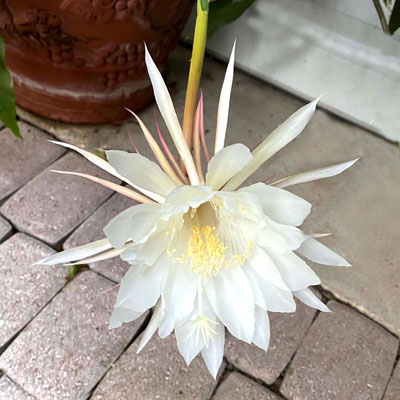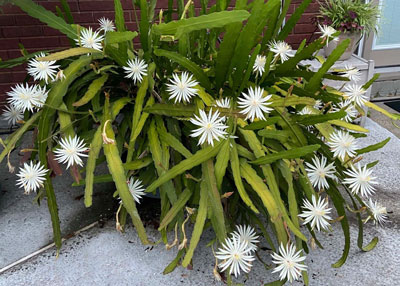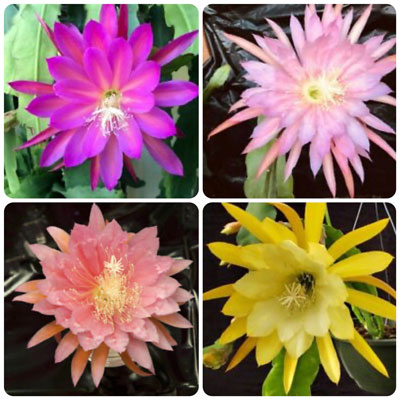Beauty in the Night

Here are some of the basic facts you’ll want to know about this fascinating group of plants…
• They are members of the Cactus plant family.
• They have no thorns.
• They grow suspended in trees (like many bromeliads and orchids).
• They are native to tropical rainforests.
• The plants can get huge (to 5 or 7 feet across).
• Epiphyllums grow best in dappled sun or moderate shade – no direct sun in the summer. (Remember: they’re native to rainforests.)
• They require very porous potting soil (like you would expect to form naturally in the crotches of tree trunks).
• Terra cotta or concrete pots are best to counteract weight of the large plants.
• Also called “orchid cacti” because of their very showy blooms, epiphytic nature and downward-hanging growth.
• Most types are white-flowering, although breeders have introduced scores of red, pink and purple hybrids.

• Blooms last only one night, but are produced in great numbers, usually during summer and fall.
• Most types are fragrant while blooming.
• Some produce showy red fruit following flowering.
• Plants are easily started from cuttings.
Sources…
You may be lucky enough to have a friend or grandma who will share a cutting of an old-fashioned white “Epi” with you. Many local independent retail nurseries offer them in with their other succulent plants, so that’s another reliable source.
And, there are online specialists selling them, often from California. I haven’t bought from any, so I’m hesitant to recommend any specific one.

However, eBay remains a good possibility and it’s still a great time to have plants and cuttings shipped in (before it turns cold). I just did an eBay search for “Epiphyllum” and there are currently more than 1,000 plants being offered, including some spectacular and colorful hybrids.
I prefer to buy only from vendors with ratings of 99 percent positive and greater and from the United States. But that’s my own personal preference. (I’ve bought perhaps 400 haworthias, aloes and bromeliads and I’ve only been disappointed one time – because I didn’t read the description carefully enough.)
Is there a group for these plants?
The real enthusiasts of these fascinating plants center in California. Their website’s home page has some years-old information, but the dates for their meetings and events seem current. If you’re serious about these plants, you might want to consider joining: http://epiphyllums.org.
